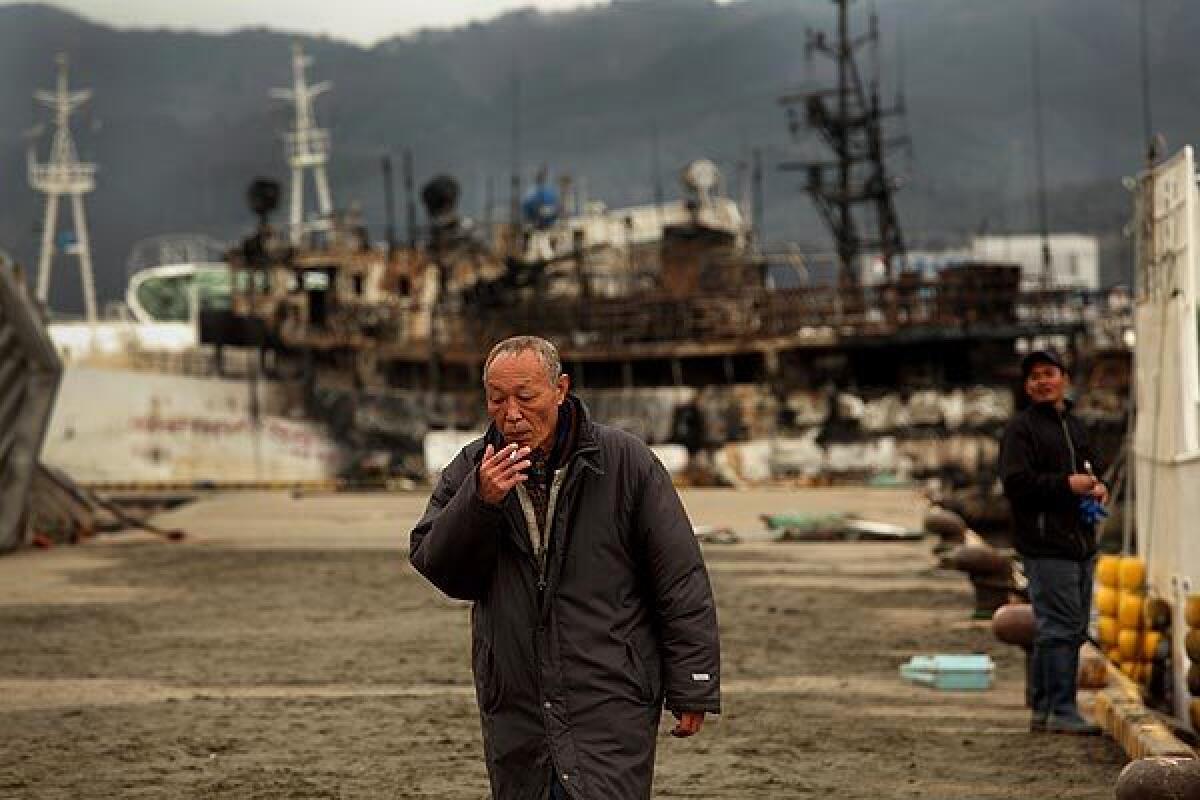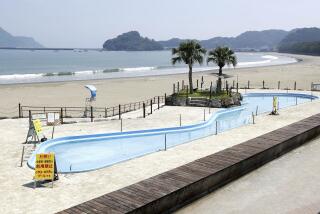Japan’s fishing industry a major casualty of nuclear crisis

- Share via
Reporting from Kesennuma, Japan, and Tokyo — Standing on the deck of his 91-foot trawler, veteran fisherman Tomoyuki Kondou winces over reports that radioactivity from Japan’s damaged nuclear power plant in nearby Fukushima has contaminated the local food supply after this month’s deadly earthquake and tsunami.
The bespectacled third-generation angler has heard the warnings that milk, spinach and other vegetables grown around the plant have been found to contain traces of the radioactive isotopes iodine-131 and cesium-137.
Now Kondou and others in Kesennuma worry that radiation from the seaside nuclear plant might also affect the region’s long-bustling fishing industry, which provides tuna, oysters, shark, squid and seaweed to restaurants and supermarkets throughout Japan and around the world.
Photos: Japan’s earthquake, tsunami and nuclear crisis
Japanese officials this week said they have detected higher than normal radiation levels in samples of seawater around the power complex. Kondou is concerned that dangerous isotopes might soon sicken the huge schools of tuna he reels onto his trawler, the 31 Kohei Maru.
“I worry the radiation might move up the food chain,” says Kondou, 40, who was more than 300 miles from shore searching for fish when the quake struck March 11 . “At first, the smaller fish will become infected and then will get eaten by the bigger fish.”
While the alarm is understandable, the science of radiation contamination suggests the health risks are less scary. Andrew Maidment, associate professor of radiology at the Hospital of the University of Pennsylvania, says radiation will be very heavily diluted in the large expanse of seawater off Japan’s northeastern coast, though inland fisheries such as shallow-water fish farms might face a slightly higher risk of contamination.
“These radioactive materials are highly soluble and are going to dissolve,” says Maidment, who is a consultant to the International Atomic Energy Agency.
But that may not damp ongoing fears both here and abroad, which can affect sales with the same force as reality.
At the Tsukiji fish market in Tokyo, which ships Kesennuma’s catch to ports across the globe, wholesalers say that overseas orders have been slashed and prices on some fresh fish have fallen by half due to radioactivity concerns.
In recent days, the market’s sushi bars, which usually are packed with tourists who wait more than two hours for service, have been half-empty.
At one stall, exporter Yasuhiro Yamazaki has a cellphone pressed to his ear as he fields calls from customers in the U.S., Australia, Taiwan, Hong Kong and Indonesia. They all want to know the same thing: Are Japan’s fish contaminated?
Says Yamazaki: “We are up against an invisible enemy.”
The growing concerns could cause his company, Tsukiji’s largest exporter, to lose $10 million, roughly 20% of his annual revenue.
It is unclear how much of the radioactive isotope seepage has flowed into the sea at Fukushima through sources ranging from windblown smoke settling atop the water to the possibly tens of thousands of gallons of water that have been pumped into the stricken nuclear reactors or dumped from above by helicopter. Water pumped into the reactors to cool the fuel rods is usually protected from contamination by a zirconium casing, but casings have melted in overheated reactors, exposing any water moving past to high levels of radiation. As workers seek to repair the Fukushima Daiichi nuclear plant, the impact of radioactivity on comestibles produced here is intensifying. Officials have now urged consumers not to eat a dozen types of vegetables from Fukushima prefecture after traces of iodine-131 and cesium-137 were found in the region. The U.S. Food and Drug Administration has banned imports of milk, fresh fruit and vegetables from four areas near the nuclear plant.
On Wednesday, government officials in Tokyo and five nearby cities announced that infants should no longer consume tap water because elevated levels of radioactive iodine were found at a water treatment plant.
This week’s report on seawater has heightened fishermen’s concerns about their wares, the nation’s signature export, even though the government has said the seafood is safe to eat.
The northeast, where the quake and tsunami hit, plays a vital role in Japan’s $16.5-billion annual fishing industry and harbor towns such as Kesennuma already are reeling from nature’s devastation.
“I wonder whether this town can survive,” says Kondou, who has gone to sea since he was 15 and now fills the shiny hip boots of his father and grandfather before him. “I hope it can, but I’m not sure.”
Kesennuma, 250 miles north of Tokyo, lies close to the epicenter of the offshore quake that shook this island nation to its core and triggered 40-foot waves that pounded its port like a storm-battered ship at sea.
Scores of the town’s signature fishing boats were tossed about like children’s toys, coming to rest blocks from the harbor, on top of cars or protruding from buildings, as the waves rushed in and then sucked thousands of victims, as well as homes and vehicles, out to sea. Other vessels were scorched by a massive fire that broke out in the harbor.
In the bay, oyster farms were ripped apart, the baskets of precious baby shellfish hopelessly scattered by the powerful waves.
Now Kesennuma lies largely in ruins and the nation’s fisheries agency predicts that a significant portion of the country’s annual seafood catch could be affected by the earthquake and tsunami, including radiation.
Not far from the berth where Kondou has ported his trawler, a mammoth fish processing plant and rows of adjacent fishing company offices lie in tatters, their records scattered in the wreckage. Hundreds, if not thousands, of residents remain missing.
On a recent morning, Yoko Tsurumoto rifled through the waterlogged remains of her fishing company office a block from the Kesennuma harbor. She and many of her 44 employees watched as one of the firm’s four fishing trawlers burned.
Ten days later, she was trying so salvage business records she insists are invaluable to keeping her family’s 60-year-old business afloat. She pulled some folders from a blue plastic crate hauled from the office and declared, “It’s all ruined.”
But even as the town ponders ways to begin rebuilding its hallowed harbor, residents say they are helpless in the face of fears about radioactive fish.
“Natives cherish this port and want to rebuild,” says Kenzo Onodera, who owns a fish distribution company here. “But they’re helpless against rumors that our fish are racked by radiation.”
Of Kesennuma’s 68,000 residents, 25,000 are employed in the fishing industry, Onodera says. If people won’t buy their fish, he adds, the community will fall apart.
Over the weekend, 300 industry leaders gathered in Kesennuma to unveil an ambitious plan to reopen the harbor by June. But there were whispers among the deckhands and trawler captains that a world that was once crazy over Japanese sushi would now turn up its nose at the daily catch.
Kondou, bespectacled with a wispy mustache and goatee, dressed in a T-shirt that read “the Doomsday Distraction,” says he simply wants to get back out at sea.
When the earthquake struck, he says, he knew immediately that something was wrong because his boat was racked by a series of strange successive waves.
Using their cellphones, he and his 12 crewmen learned of the quake and its devastation. They quickly headed toward shore, passing a flotilla of floating houses, cars, trucks and bodies on the way.
Days later, Kondou wonders whether there will be a fishing industry left when his son, 5, is old enough to enter the business: “I don’t know what is more dangerous to a fisherman these days — the radiation or the rumors.”
Photos: Japan’s earthquake, tsunami and nuclear crisis
Times staff writer Glionna reported from Kesennuma and special correspondent Hall from Tokyo. Staff writers Alan Zarembo and Amina Khan in Los Angeles contributed to this report.
More to Read
Sign up for Essential California
The most important California stories and recommendations in your inbox every morning.
You may occasionally receive promotional content from the Los Angeles Times.














